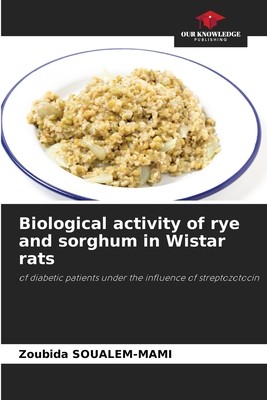
- We will send in 10–14 business days.
- Author: Zoubida Soualem-Mami
- Publisher: Our Knowledge Publishing
- ISBN-10: 620785327X
- ISBN-13: 9786207853274
- Format: 15.2 x 22.9 x 0.7 cm, softcover
- Language: English
- SAVE -10% with code: EXTRA
Biological activity of rye and sorghum in Wistar rats (e-book) (used book) | bookbook.eu
Reviews
Description
Changes in dietary habits in recent years have led to the emergence of so-called civilization diseases, among them diabetes mellitus, characterized by current hyperglycemia caused by a deficit in insulin secretion or cellular insulin resistance. Dietary approaches favor the consumption of cereal products in the most complete form possible. Sorghum (Sorghum bicolor L.), a well-known species as an important source of polyphenols, is the world's fifth-largest cereal crop after wheat, rice, maize and barley. Rye (Secale cereale L.) was a relatively late arrival in agriculture, at least as a crop in its own right. These two coarse grains were chosen because of their therapeutic properties, and because they have been little investigated in comparison with other cereals such as wheat and barley. The aim of this work is to test the effect of phenolic extracts from the two cereals on antioxidant power in vitro, and then to verify the efficacy of experimental diets based on whole grains in correcting hyperglycemia and dyslipidemia.
EXTRA 10 % discount with code: EXTRA
The promotion ends in 18d.19:11:59
The discount code is valid when purchasing from 10 €. Discounts do not stack.
- Author: Zoubida Soualem-Mami
- Publisher: Our Knowledge Publishing
- ISBN-10: 620785327X
- ISBN-13: 9786207853274
- Format: 15.2 x 22.9 x 0.7 cm, softcover
- Language: English English
Changes in dietary habits in recent years have led to the emergence of so-called civilization diseases, among them diabetes mellitus, characterized by current hyperglycemia caused by a deficit in insulin secretion or cellular insulin resistance. Dietary approaches favor the consumption of cereal products in the most complete form possible. Sorghum (Sorghum bicolor L.), a well-known species as an important source of polyphenols, is the world's fifth-largest cereal crop after wheat, rice, maize and barley. Rye (Secale cereale L.) was a relatively late arrival in agriculture, at least as a crop in its own right. These two coarse grains were chosen because of their therapeutic properties, and because they have been little investigated in comparison with other cereals such as wheat and barley. The aim of this work is to test the effect of phenolic extracts from the two cereals on antioxidant power in vitro, and then to verify the efficacy of experimental diets based on whole grains in correcting hyperglycemia and dyslipidemia.


Reviews